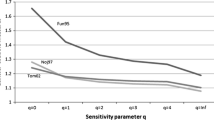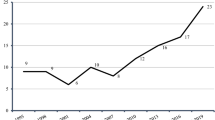Abstract
Diversity of science (variety in and balance among research subjects) is often regarded as a key driver of innovation, but it is typically understood by means of heuristics, given the lack of precise formulations such as those found in biodiversity studies. From the policy perspective, a standard methodology for characterization of diversity of science is needed to enable the efficient management and breeding of diverse research responsive to socio-economic demands. We investigated the distribution of research subjects in a bibliographic database to develop a framework of diversity of science analogous to that of biodiversity. Our analysis of the distribution of research subjects among countries suggests that diversity of science has similar statistical characteristics as biodiversity. We find that number of research subjects follows log-normal distribution for almost all countries and indicates linear dependency on research budget in log–log plot. We also identify an inflection point in the subject–budget relationship curve. The results may validate the adoption of sophisticated concepts and techniques from biodiversity work in “scientodiversity” studies.




Similar content being viewed by others
References
Abbasi, A., Altmann, J., & Hossain, L. (2011). Identifying the effects of co-authorship networks on the performance of scholars: A correlation and regression analysis of performance measures and social network analysis measures. Journal of Informetrics, 5(4), 594–607. doi:10.1016/j.joi.2011.05.007.
Aydinoglu, A. U., Allard, S., & Mitchell, C. (2015). Measuring diversity in disciplinary collaboration in research teams: An ecological perspective. doi:10.1093/reseval/rvv028.
Barjak, F. (2006). Team diversity and research collaboration in life sciences teams: Does a combination of research cultures pay off? University of Applied Sciences Northwestern Switzerland, Series A: Discussion Paper, W02. Retrieved from http://netreact-eu.org/documents/DPW2006-02_TeamDiversity_Barjak_Franz.pdf.
Börner, K. (2010). Atlas of science: Visualizing what we know. Cambridge: The MIT Press.
Bosman, J., van Mourik, I., Rasch, M., Sieverts, E., & Verhoeff, H. (2006). Scopus reviewed and compared. Utrecht: Utrecht University Library.
Carley, S., & Porter, A. L. (2012). A forward diversity index. Scientometrics, 90, 407–427. doi:10.1007/s11192-011-0528-1.
Chaminade, C., & Plechero, M. (2014). Do regions make a difference? Regional innovation systems and global innovation networks in the ICT industry. European Planning Studies, 23(2), 215–237. doi:10.1080/09654313.2013.861806.
Confraria, H., & Godinho, M. M. (2014). The impact of African science: A bibliometric analysis. Scientometrics, 102(2), 1241–1268. doi:10.1007/s11192-014-1463-8.
Confraria, H., Mira Godinho, M., & Wang, L. (2017). Determinants of citation impact: A comparative analysis of the Global South versus the Global North. Research Policy, 46(1), 265–279. doi:10.1016/j.respol.2016.11.004.
Gibbons, M. (1999). Science’s new social contract with society. Nature, 402, C81–C84.
Gibbons, M., Limoges, C., Nowotny, H., Schwartzman, S., Scott, P., & Trow, M. (1994). The new production of knowledge: The dynamics of science and research in contemporary societies. Contemporary sociology. London: Sage.
Hicks, D., & Katz, J. S. (2011). Equity and excellence in research funding. Minerva, 49(2), 137–151. doi:10.1007/s11024-011-9170-6.
Hubbell, S. P. (2001). The unified neutral theory of biodiversity and biogeography. Princeton: Princeton University Press.
Igami, M., & Saka, A. (2016). Decreasing diversity in Japanese science, evidence from in-depth analyses of science maps. Scientometrics, 106(1), 383–403. doi:10.1007/s11192-015-1648-9.
Irie, H., & Tokita, K. (2012). Species–area relationship for power-law species abundance distribution. International Journal of Biomathematics, 5(3), 1260014. Retrieved from http://arxiv.org/abs/q-bio/0609012.
Kitai, T. (1993). Construction of JICST scientific technological classification 1993. Journal of Information Processing and Management, 35, 967–974.
Kuhn, T. S. (1970). The structure of scientific revolutions. Chicago: The University of Chicago Press. doi:10.1119/1.1969660.
Lee, Y. N., Walsh, J. P., & Wang, J. (2015). Creativity in scientific teams: Unpacking novelty and impact. Research Policy, 44(3), 684–697. doi:10.1016/j.respol.2014.10.007.
Leydesdorff, L., Carley, S., & Rafols, I. (2013a). Global maps of science based on the new web-of-science categories. Scientometrics, 94, 589–593. doi:10.1007/s11192-012-0784-8.
Leydesdorff, L., & Rafols, I. (2011). Indicators of the interdisciplinarity of journals: Diversity, centrality, and citations. Journal of Informetrics, 5, 87–100. doi:10.1016/j.joi.2010.09.002.
Leydesdorff, L., Rafols, I., & Chen, C. (2013b). Interactive overlays of journals and the measurement of interdisciplinarity on the basis of aggregated journal–journal citations. Journal of the American Society for Information Science and Technology, 64, 2573–2586. doi:10.1002/asi.
Limpert, E., Stahel, W. A., & Abbt, M. (2001). Log-normal distributions across the sciences: Keys and clues. BioScience, 51(5), 341–352.
Lund Declaration. (2009). Europe must focus on the grand challenges of our time. In Swedish Presidency Research Conference in Lund. New Times New Solutions. Lund. Retrieved from http://www.vr.se/download/18.7dac901212646d84fd38000336/.
MacArthur, R. H., & Wilson, E. O. (1967). The theory of island biogeography. Princeton: Princeton University Press. doi:10.2307/1796430.
Malerba, F. (2002). Sectoral systems of innovation and production. Research Policy, 31, 247–264.
May, R. M. (1972). Will a large complex system be stable? Nature, 238, 413–414.
May, R. M. (1975). Patterns of species abundance and diversity. In M. L. Cody & J. M. Diamond (Eds.), Ecology and evolution of communities (pp. 81–120). Cambridge: The Belknap Press.
May, R. M. (1999). Unanswered questions in ecology. Philosophical Transactions of the Royal Society of London. Series B, Biological Sciences, 354(1392), 1951–1959. doi:10.1098/rstb.1999.0534.
Merton, R. K. (1973). The Normative Structure of Science. In N. Storer (Ed.), The sociology of sciene: Theoretical and empirical investigations (pp. 267–278). Chicago: The University Chicago Press.
Mitesser, O., Heinz, M., Havemann, F., & Gläser, J. (2008). Measuring diversity of research by extracting latent themes from bipartite networks of papers and references. In H. Kretschmer & F. Havemann (Eds.), Proceedings of WIS 2008, 6th international conference on webometrics, informetrics and scientometrics & ninth COLLNET meeting. Berlin.
Mougi, A., & Kondoh, M. (2012). Diversity of interaction types and ecological community stability. Science, 337(6092), 349–351. doi:10.1126/science.1220529.
Mugabushaka, A. M., Kyriakou, A., & Papazoglou, T. (2016). Bibliometric indicators of interdisciplinarity: The potential of the Leinster–Cobbold diversity indices to study disciplinary diversity. Scientometrics, 107(2), 593–607. doi:10.1007/s11192-016-1865-x.
Nelson, R. (Ed.). (1993). National innovation systems: A comparative analysis. Oxford: Oxford University Press.
Newman, M. E. J. (2005). Power laws, Pareto distributions and Zipf’s law. Contemporary Physics, 46(5), 323–351. doi:10.1016/j.cities.2012.03.001.
OECD. (2016). OECD Science, Technology and Industry Outlook. OECD. https://doi.org/10.1787/23129638.
Paine, R. T. (1995). A conversation on refining the concept of keystone species. Conservation Biology, 9(4), 962–964. doi:10.1046/j.1523-1739.1995.09040962.x.
Pan, R. K., Sinha, S., Kaski, K., & Saramäki, J. (2012). The evolution of interdisciplinarity in physics research. Scientific Reports, 2, 1–8. doi:10.1038/srep00551.
Power, M. E., Tilman, D., Estes, J. A., Menge, B. A., Bond, W. J., Mills, L. S., et al. (1996). Challenges in the quest for keystones. BioScience, 46(8), 609–620. doi:10.2307/1312990.
Preston, F. W. (1962). The canonical distribution of commonness and rarity: Part I. Ecology, 43(2), 185–215.
Preston, F. W. (1980). Noncanonical distributions of commonness and rarity. Ecology, 61(1), 88–97.
Rafols, I., & Meyer, M. (2010). Diversity and network coherence as indicators of interdisciplinarity: Case studies in bionanoscience. Scientometrics, 82(2), 263–287. doi:10.1007/s11192-009-0041-y.
Rosenberg, N. (1996). Uncertainty and technological change. In G. W. R. Landau & T. Taylor (Eds.), The mosaic of economic growth (pp. 334–353). Stanford: Stanford University Press.
Sakagami, Y. (1989). JICST science and technology classification. The Journal of Information Science and Technology Association, 39(11), 497–502.
Schmidt, M., Glaser, J., Havemann, F., & Heinze, M. (2006). A methodological study for measuring the diversity of science. In Proceedings international workshop on webometrics, informetrics and scientometrics & seventh COLLNET meeting. Nancy.
Shibayama, S. (2011). Distribution of academic research funds: A case of Japanese national research grant. Scientometrics, 88(1), 43–60. doi:10.1007/s11192-011-0392-z.
Shimada, Y., Tsukada, N., & Suzuki, J. (2017). Promoting diversity in science in Japan through mission-oriented research grants. Scientometrics, 110(3), 1415–1435. doi:10.1007/s11192-016-2224-7.
Stirling, A. (2007). A general framework for analysing diversity in science, technology and society. Journal of the Royal Society, Interface, 4(15), 707–719. doi:10.1098/rsif.2007.0213.
The World Bank. (2017). World Development Indicators. Retrieved from http://data.worldbank.org/data-catalog/world-development-indicators.
Trajtenberg, M., Henderson, R., & Jaffe, A. (1997). University versus corporate patents: A window on the basicness of invention. Economics of Innovation and New Technology. doi:10.1080/10438599700000006.
Uzzi, B., Mukherjee, S., Stringer, M., & Jones, B. (2013). Atypical combinations and scientific impact. Science, 342, 468–472. doi:10.1126/science.1240474.
Van Noorden, R. (2015). Interdisciplinary research by the numbers. Nature, 525, 306–307.
Voutilainen, A., & Kangasniemi, M. (2015). Applying the ecological Shannon’s diversity index to measure research collaboration based on coauthorship: A pilot study. Journal of Scientometric Research, 4, 172–177. doi:10.4103/2320-0057.174866.
Wagner, S. C. (2010). Keystone species. Nature Education Knowledge, 3(10), 51. doi:10.1007/978-3-642-58001-7_11.
Wagner, C. S., Roessner, J. D., Bobb, K., Klein, J. T., Boyack, K. W., Keyton, J., et al. (2011). Approaches to understanding and measuring interdisciplinary scientific research (IDR): A review of the literature. Journal of Informetrics, 5(1), 14–26. doi:10.1016/j.joi.2010.06.004.
Williams, K. Y., & O’Reilly, C. A. (1998). Demography and diversity in organizations: A review of 40 years of research. Research in Organizational Behavior, 20, 77–140.
Author information
Authors and Affiliations
Corresponding author
Electronic supplementary material
Below is the link to the electronic supplementary material.
Rights and permissions
About this article
Cite this article
Shimada, Ya., Suzuki, J. Promoting scientodiversity inspired by biodiversity. Scientometrics 113, 1463–1479 (2017). https://doi.org/10.1007/s11192-017-2545-1
Received:
Published:
Issue Date:
DOI: https://doi.org/10.1007/s11192-017-2545-1




